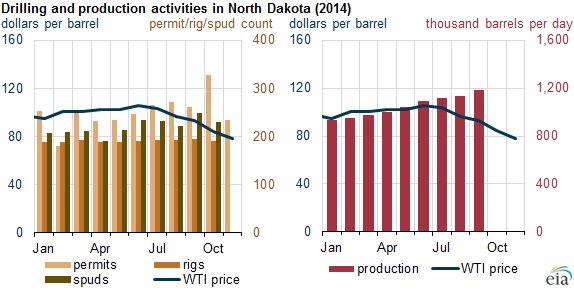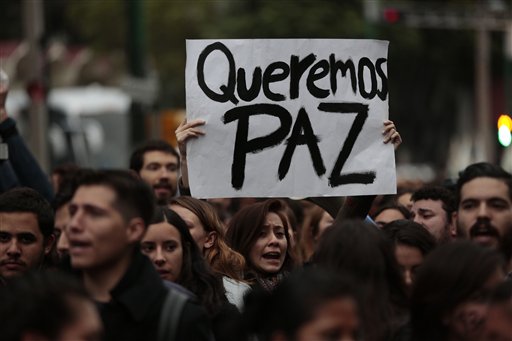 This morning’s key headlines from GenerationalDynamics.com
This morning’s key headlines from GenerationalDynamics.com
- Lynchings of 43 students revive the Mexican Revolution
- Oil production to increase despite, or because of, crashing prices
Lynchings of 43 students revive the Mexican Revolution

Wanted poster for Pancho Villa – March 9, 1916. He was wanted in Columbus, New Mexico, for killing American citizens in Mexico
On September 26, a group of 43 students in a rural teachers’ collegein Ayotzinapa, Guerrero in southern Mexico all disappeared, whiletraveling to the town of Iguala for an anti-government demonstration.At first it was believed that criminals from drug cartels had abductedand killed the students. But later it turned out that José LuisAbarca, the former mayor of Iguala, working hand in hand with thepolice and the drug traffickers, ordered the lynchings. The 43students were believed to be burned and dumped, though only theremains of one have been found. Abarca was later arrested byfederal officers and charged with murder.
These atrocities led to violent mass protests in Mexico City lastmonth. They are inflaming the fault lines of the Mexican Revolutionof the 1910s. Mexico’s last crisis war was the Mexican Revolution,running from 1910-1922, so Mexico is deep into a generational Crisisera, and overdue for a new crisis war, from the point of view ofGenerational Dynamics.
Mexico is like other Latin American countries in that the major faultlines are between the indigenous peoples (“Amerindians”) and theindigenous descendants of French and Spanish settlers. The indigenouspeoples in Mexico are the Mayans in the south and the Aztecs andCommancheros in the north. The French and Spanish descendantsgenerally live in the center, around Mexico City. During the MexicanRevolution of the 1910s, Pancho Villa (from the north) was the leader,along with Emiliano Zapata, of the indigenous rebel insurgency groupsin the south.
Ayotzinapa is in a region populated mostly by indigenous Mayandescendants. The students were called “normalistas” because they wentto a “normal” college, one of those that were set up in the 1920s,following the Mexican Revolution, to help the poor indigenous people.
José Luis Abarca was born nearby in Arcelia, Guerrero. He started outpoor but got into the gold business and, as a member of the DemocraticRevolution Party (PRD), became mayor of Iguala in June 2012, despitehaving no political experience. He and his wife María de los Ángeleshad ruled as “the Imperial Couple.” Three of María’s brothers weredrug traffickers, but had been killed or captured.
The atrocities and massive corruption are pushing all the buttons ofthe indigenous activists. From the point of view of GenerationalDynamics, Mexico is headed for a new war, refighting the MexicanRevolution of the 1910s along the fault line separating the people ofEuropean ancestry versus the indigenous peoples. This war may spreadinto southwestern United States, as there are Aztec descendants in theAztlán movement who claim that the southwest really belongs to them,and was their ancestral homeland. Reuters and Vice News and Yucatan Times
Oil production to increase despite, or because of, crashing prices
Oil prices have been plunging due to increased supply from US shaleproduction (fracking), and due to falling demand caused by a slowingworld economy. The oil importing countries (Indonesia, India, Taiwan,South Korea, Japan) are benefiting enormously from the plunge in oilprices, while it’s a disaster for several oil exporting countries –Venezuela, Russia, Iran, Iraq, Nigeria. Saudi Arabia has announced itwill try to increase oil production, presumably in the hope of puttingthe US fracking industry out of business.
An analysis by the US Energy Information Administration (EIA) mayshed some light on what’s going on. Even though the price of oil isplummeting, US fracking production is going to continue increasing,though perhaps slightly less rapidly than has been previouslypredicted.

Oil production in 2014. WTI is West Texas Intermediate (EIA)
The graph on the left shows that drilling permits have been holdingsteady, while the number of rigs has fallen slightly. The graph onthe right shows that oil production continues to increase, despite thefall in oil prices.
The existing wells are backed by hedge funds and junk bonds that arenow in distress because of the fall in prices. As a result,production in the existing wells will actually be increased as much asphysically possible, to generate revenue at low oil prices to meetmargin calls for these junk bonds.
It occurs to me that the Saudis may be in a similar situation. Theymay also have shaky investments backing up their oil wells, and sothey too would have to keep production as high as possible to maketheir own margin calls.
This is a good illustration of how deflation feeds on itself, and howsome deflation causes more deflation, almost as if were caused by adeflationary attitude. By the law of supply and demand, fallingprices normally should cause production to decrease. But the currentsituation we’re in, a highly leverage debt bubble, is an anomaloussituation. Falling oil prices are causing production to increase, notbecause of the oil market, but because of the debt market, resultingin a deflationary spiral. Businesses desperately increase productionand sales in the hope of making up for lost earnings, in order to meettheir debt margin calls, but the increased supply simply causes pricesto fall even faster, resulting in more deflation.
This is a dangerous situation because, as the price of oil continuesto fall, one or more of these funds may go bankrupt, and that maycause a chain reaction of multiple bankruptcies. US Energy Information Administration (EIA) and Investment Watch/Wolf Richter
KEYS: Generational Dynamics, Mexico, Mexican Revolution,Iguala, Ayotzinapa, Guerrero,José Luis Abarca, María de los Ángeles,Indonesia, India, Taiwan, South Korea, Japan,Venezuela, Russia, Iran, Iraq, Nigeria, Saudi Arabia,US Energy Information Administration, EIA
Permanent web link to this article
Receive daily World View columns by e-mail

COMMENTS
Please let us know if you're having issues with commenting.